Healthcare providers manage an enormous volume of data daily, approximately 137 terabytes, most of which is unstructured. This includes a wide array of formats such as medical images, clinical notes, and genetic test results. Unstructured data, crucial for patient care, poses significant challenges due to its complexity and the varied sizes of its components.
The volume of healthcare data is rapidly increasing, fueled by the widespread adoption of electronic health records and advances in medical technology, growing at a rate of about 47% per year. For example, the size difference in medical images is substantial: a standard chest X-ray might be 15 megabytes, while a digital pathology file can reach up to 3 gigabytes, the size of a high-definition movie. These factors complicate storage, retrieval, and analysis.
With 80% of healthcare data being unstructured, effectively managing and utilizing this data is a major challenge in today's healthcare landscape. In the sections that follow, we will delve deeper into the challenges of handling unstructured healthcare data and show how Jackalope offers essential solutions to these challenges.
In healthcare, data appears in different formats, each with its own challenges and advantages. Structured data is crucial for easy management and quick analysis, while unstructured data contains detailed information essential for thorough patient care. Knowing the differences between these data types is key to using them effectively to improve patient care and make healthcare operations more efficient.
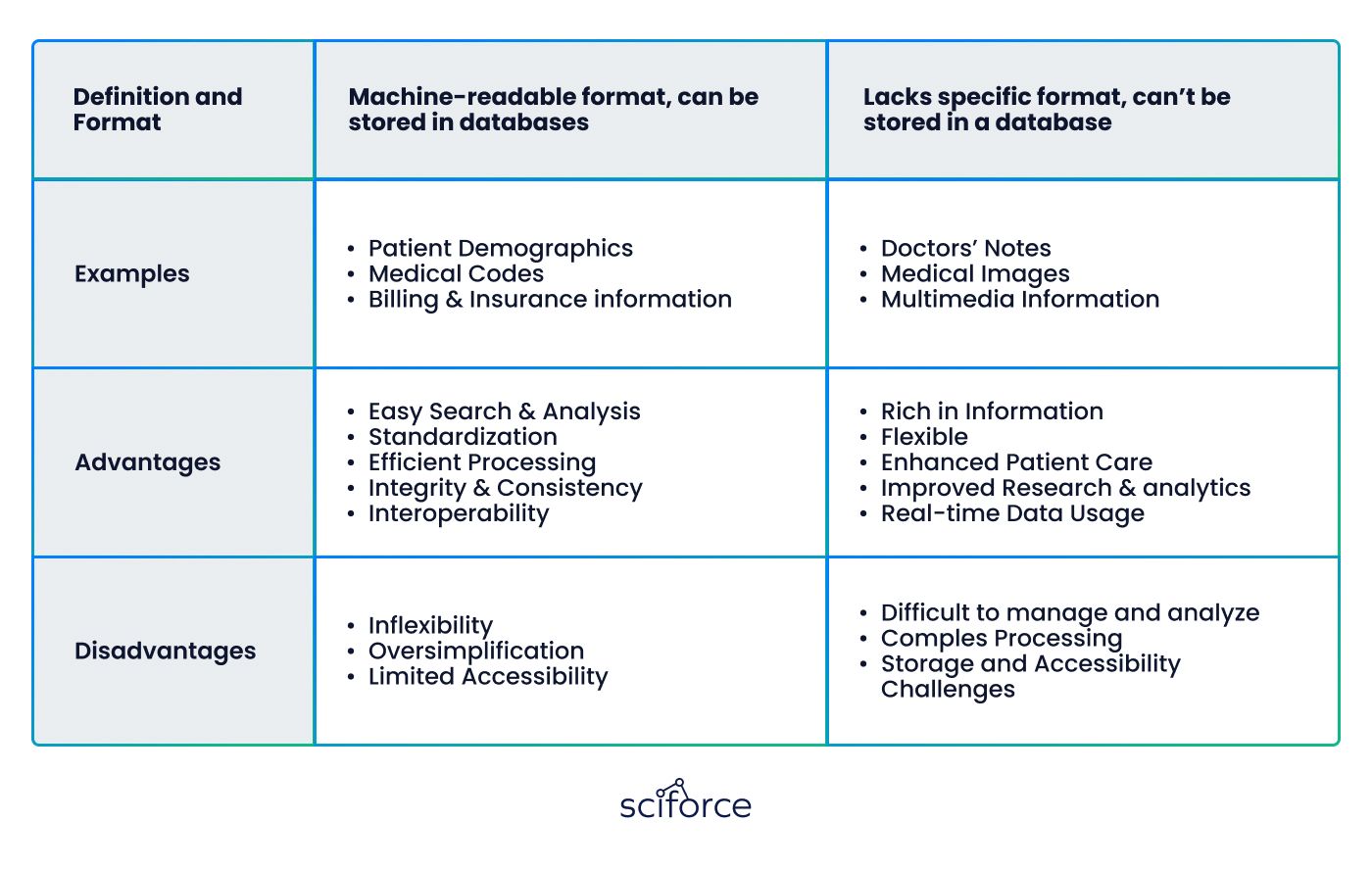
Structured data is highly organized and formatted in a way that is easy for machines to read and query. Typically stored in traditional relational databases, structured data can be easily entered, stored, queried, and analyzed using standard tools and methods.
1. Examples
Structured data is commonly found in specific, predefined formats that are easy to manage and analyze. Examples include:
2. Advantages
Structured data offers several key benefits that make it highly valuable in healthcare settings:
- Ease of Search and Analysis
Due to its organized nature, structured data can be quickly searched using queries, and statistical analysis can be easily performed. For example, healthcare providers can quickly retrieve patient demographic information or medical history by searching through structured fields in an EHR system.
- Standardization
Structured data adheres to a predefined schema with specific formats and columns, simplifying data collection, entry, and exchange between systems. This standardization ensures that data such as diagnosis codes (ICD-10) and procedure codes (CPT) are consistently recorded and understood across different healthcare systems.
- Efficiency in Processing
Structured data is optimized for efficient data processing and management in EHR systems and other healthcare databases. This means that tasks such as patient record updates, billing, and insurance processing can be performed quickly and accurately due to the structured nature of the data.
- Data Integrity and Consistency
Structured data follows strict formats and validation rules, which helps maintain data integrity and consistency across different systems and over time. This reliability is crucial for accurate patient records and regulatory compliance.
- Interoperability
The standardized nature of structured data facilitates easy data sharing and integration between different healthcare providers and systems. This interoperability supports coordinated care and enhances the overall efficiency of healthcare delivery.
3. Disadvantages
Structured data provides a foundation for efficient data management and analysis but may fall short in capturing the detailed information needed for comprehensive patient care.
- Inflexibility
Structured data is restricted to predefined fields, which means it cannot easily capture complex or nuanced clinical information that does not fit into these categories. For instance, a detailed patient narrative or unique symptoms may not be fully documented.
- Data Oversimplification
The rigid structure may oversimplify patient information, potentially missing critical details. For example, structured data might record that a patient has a cough, but it may not capture the context or severity as well as unstructured data, like detailed clinical notes, would.
- Limited Adaptability
Structured data systems struggle to update with new medical knowledge and practices. Adding new diagnostic criteria or treatment protocols can be time-consuming and complex, delaying implementation. They also find it hard to integrate new data types like genomic information or wearable device data, limiting their flexibility.
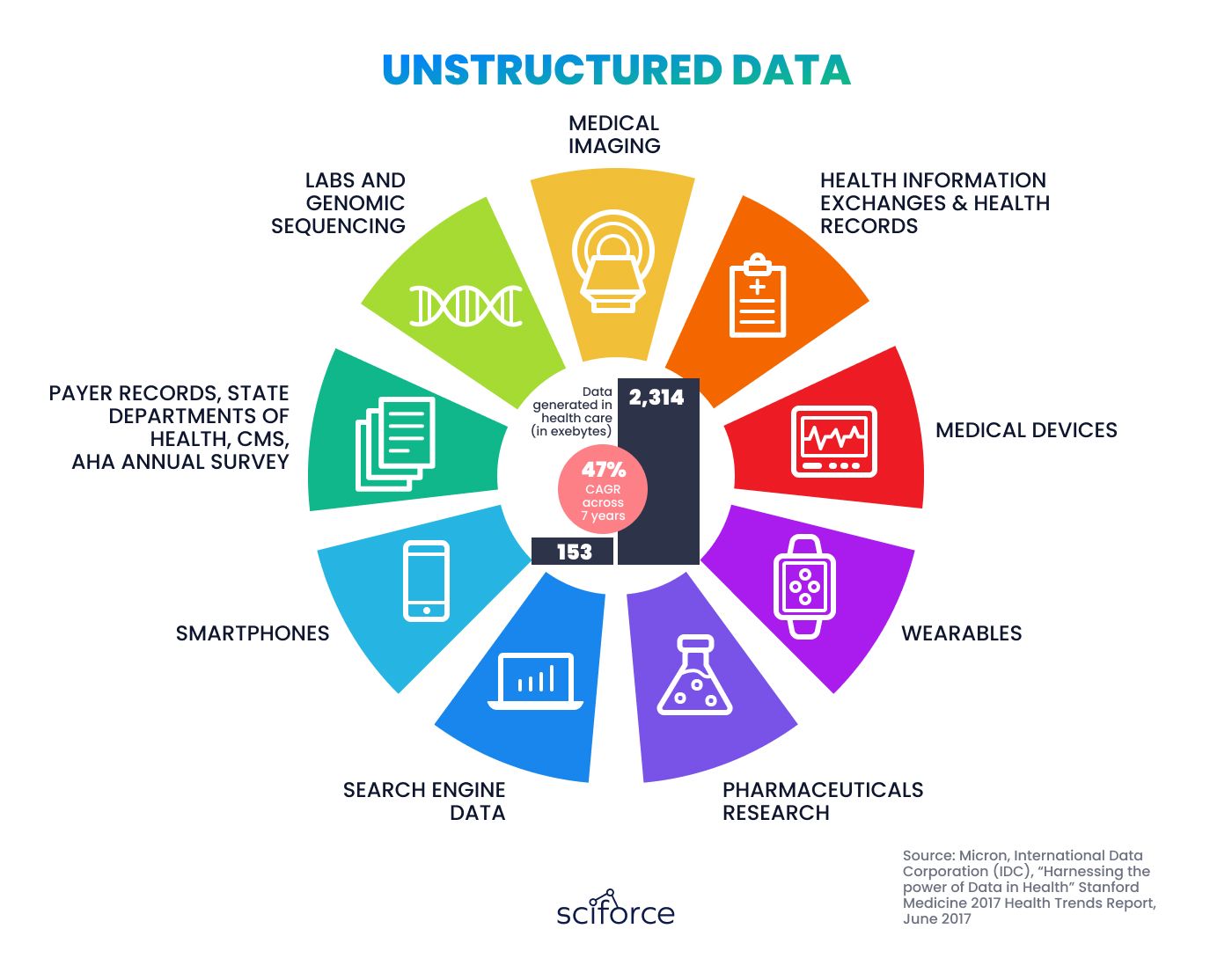
Unstructured data is not organized in a predefined manner and lacks a specific format, making it difficult for traditional data management systems to interpret without advanced processing tools. It is typically stored in formats that do not fit neatly into relational databases.
1. Examples
Unstructured data is prevalent in healthcare, manifesting in various detailed formats that provide rich and nuanced information, including:
2. Advantages
Unstructured data provides detailed patient information, supports personalized treatments, and aids advanced medical research, thereby improving the quality and depth of healthcare information:
- Richness of Information
Unstructured data includes comprehensive details such as patient histories, physician notes, and diagnostic images. This provides deeper insights into patient conditions, leading to more accurate diagnoses and tailored treatments.
- Flexibility
It can capture various types of information from multiple sources, including text, images, and multimedia. This allows healthcare providers to document and use diverse information, reflecting the complex nature of medical care.
- Enhanced Patient Care
By incorporating detailed narratives, imaging data, and multimedia, unstructured data offers a more complete picture of a patient's health, supporting more holistic and effective care.
- Improved Research and Analysis
The rich detail in unstructured data is invaluable for medical research and clinical studies. Advanced analytics and machine learning techniques can uncover patterns and insights not evident in structured data, driving innovations in treatment and healthcare practices.
- Real-Time Data Utilization
Unstructured data, such as real-time patient monitoring feeds and voice recordings, can be analyzed immediately, providing crucial insights for urgent clinical decisions.
3. Disadvantages
While unstructured data offers numerous benefits, it also presents specific challenges that can complicate its use in healthcare
- Difficult to Manage and Analyze
Unstructured data lacks a predefined format, making it hard to organize, search, and analyze. Technologies like natural language processing (NLP) and machine learning are needed to extract insights, such as converting physician notes into searchable data.
- Complex Processing Requirements
Handling unstructured data requires advanced tools and significant computational power, leading to higher costs and longer processing times. Analyzing large imaging datasets or extracting information from multimedia files demands specialized software and resources.
- Storage and Accessibility Challenges
Unstructured data often requires more storage space due to the large size of images, videos, and detailed text documents. Managing and retrieving this data involves complex systems, making it less accessible for quick querying and analysis, which is critical in clinical settings.
Unstructured data accounts for approximately 80% of all healthcare data, according to industry estimates. This predominance arises from the diverse sources and types of data that healthcare environments generate, which include: Clinical Notes and Narratives: Written by physicians, nurses, and other healthcare providers, these notes are rich with patient histories, treatment plans, and other vital information.
- Medical Imaging:
Includes a wide range of imaging formats such as X-rays, MRIs, CT scans, and ultrasound images, each containing detailed visual information about patient conditions.
- Genomic Data:
Sequencing results produce large volumes of data that are key for personalized medicine but are inherently complex and unstructured.
- Research and Clinical Trial Data:
Text-heavy documents, research notes, and informed consents, which are essential for advancing medical knowledge.
- Multimedia:
Videos from surgeries or other procedures, audio recordings from patient consultations, and photographic data from dermatological examinations or wound care.
- Emails and Communication Records:
Correspondence between healthcare professionals and between professionals and patients can contain observations and treatment outcomes.
These sources highlight not just the variety but also the sheer volume of unstructured data within healthcare systems.
Rich Clinical Insights
Unstructured data holds detailed and nuanced information that is often lost in structured datasets. For example, a doctor’s notes might include observations about a patient's response to a treatment that aren't captured in structured form fields but are crucial for understanding outcomes.
Personalized Patient Care
The depth of information in unstructured formats like clinical narratives and genomic data can lead to more personalized and precise treatment plans. By analyzing this data, healthcare providers can tailor treatments to individual patients based on a deeper understanding of their unique health profiles.
Enhanced Medical Research and Innovation
Unstructured data is a goldmine for research, providing the raw detailed information necessary for groundbreaking studies and medical discoveries. When researchers have access to comprehensive data sets, they can identify patterns and connections that might be invisible in more rigid structured data.
Improved Healthcare Outcomes
By integrating and analyzing unstructured data, healthcare providers can improve diagnostic accuracy, track disease progression more effectively, and monitor treatment outcomes in real-time, leading to better overall healthcare delivery.
Maintaining Data Integrity with Volatile Healthcare Data
Unstructured data, often entered in various forms by different healthcare providers, can vary significantly in quality and format. This variability can lead to inconsistencies that undermine data integrity. Ensuring that all data reflects accurate and up-to-date information remains a significant challenge, especially when dealing with rapidly changing health statuses and treatments.
Storing Vast Amounts of Data
The sheer volume of unstructured data generated by modern healthcare systems is staggering. From high-resolution medical images to lengthy patient narratives, storing this data requires extensive infrastructure. Healthcare organizations must invest in scalable storage solutions that can accommodate growth without compromising access or performance.
Securing Data in the Wake of Cyber Attacks
Healthcare data is a prime target for cybercriminals due to its sensitive nature and the valuable information it contains. Unstructured data, which often includes personal patient details, is particularly vulnerable. Protecting this data from breaches requires robust security measures, including advanced encryption methods and continuous monitoring of data access and usage.
Data Sharing Across Providers
To improve population health and support value-based care models, healthcare providers need to share data efficiently across various systems and organizations. However, unstructured data's diverse formats and standards pose significant interoperability challenges, making it difficult to share information seamlessly and securely.
Protecting and Owning Health Data
With the rise of digital health records and patient-generated data, issues of data ownership and privacy have become increasingly complex. Patients and providers must navigate the legal and ethical implications of data management, ensuring that patients' rights to privacy are respected while still enabling the necessary use of their data for their care.
Addressing Bias in Data That Lead to Inequities in Care
Unstructured data is subject to biases inherent in the data collection process, such as those introduced by subjective observations or uneven documentation practices. These biases can perpetuate inequities in care, as algorithms and analyses based on this data may not accurately represent all patient groups. Identifying and correcting these biases is crucial to developing fair and effective healthcare practices.
Since unstructured data lacks a predefined format, making it difficult to store, search, and interpret using traditional methods, it requires more advanced processing methods. AI technologies, including natural language processing (NLP) and machine learning, provide them.
They streamline the handling of unstructured data, enhancing its usability and unlocking valuable insights for improved patient care and operational efficiency.
Automated Data Standardization and Validation
This process leverages advanced Natural Language Processing (NLP) and machine learning algorithms to systematically transform unstructured healthcare data, including clinical notes, patient records, and diagnostic reports, into standardized, structured formats.
These technologies parse clinical narratives and lab results, identifying key health information such as symptoms, diagnoses, medication dosages, and procedural outcomes. After extraction, this data is accurately mapped to standardized healthcare schemas like HL7 FHIR or OMOP CDM.
This ensures that the data aligns with universally accepted medical terminologies and interoperable formats, facilitating comprehensive health data management across multiple platforms.
- OCR Technology
Google Cloud Vision, Tesseract (logos) Convert scanned healthcare documents and hand-written notes into editable formats, enabling easier text searching and processing.
- NLP Tools & LLMs
SpaCy, NLTK (logos) Analyze and standardize medical information from unstructured text into diagnostic and treatment codes, essential for patient care continuity.
- Machine Learning Models
TensorFlow and PyTorch (logos) Enhance data categorization and entry accuracy by continuously learning from adjustments and new inputs.
Efficient Data Storage and Advanced Compression
To address the increasing volumes of healthcare data, particularly for large files like medical images, AI-driven technologies are essential for enhancing data storage and compression. AI algorithms dynamically allocate storage resources based on usage trends and predictive analytics to optimize capacity.
For compression, advanced algorithms that incorporate machine learning minimize the size of data-heavy images such as MRIs and CT scans. These methods preserve vital diagnostic information while significantly reducing storage requirements.
AI in Health Information Exchanges (HIE) and Standardization
AI is revolutionizing Health Information Exchanges (HIE) by automating the preprocessing and standardization of diverse healthcare data into universally compatible formats. Utilizing advanced algorithms, AI systems efficiently parse, validate, and transform data from various healthcare sources – from electronic health records (EHRs) to imaging studies – into standardized formats like HL7 or FHIR. This process ensures data consistency and interoperability across different healthcare IT systems, facilitating seamless data integration into HIE platforms.
Data Parsing and Normalization
Extracting and normalizing information from unstructured data like clinical notes, preparing the data for further processing and integration.
Semantic Mapping
Using machine learning algorithms to map local data representations to standardized medical vocabularies and coding systems like SNOMED CT and LOINC.
Automated Validation and Formatting
Data validation and formatting, ensure data integrity and compliance with HL7 and FHIR standards, which support API-based access and integration.
Jackalope is an advanced AI-powered platform designed to address the challenges of unstructured healthcare data. It automates data standardization, enhances semantic integrity, efficiently handles large datasets, and ensures system compatibility and security.
Data Processing
Automating Data Standardization
Jackalope begins by automating the standardization of unstructured data.
- AI and ML Deployment
Jackalope employs advanced artificial intelligence (AI) and machine learning (ML) algorithms to process medical data gathered from various sources, such as clinical notes, lab results, and electronic health records (EHRs).
- Transformation Process
The system identifies key medical terms and contextual information within unstructured or semi-structured data. It then uses ML models to map these terms to standardized codes and descriptions found in OMOP CDM (Observational Medical Outcomes Partnership Common Data Model) and SNOMED CT (Systematized Nomenclature of Medicine – Clinical Terms).
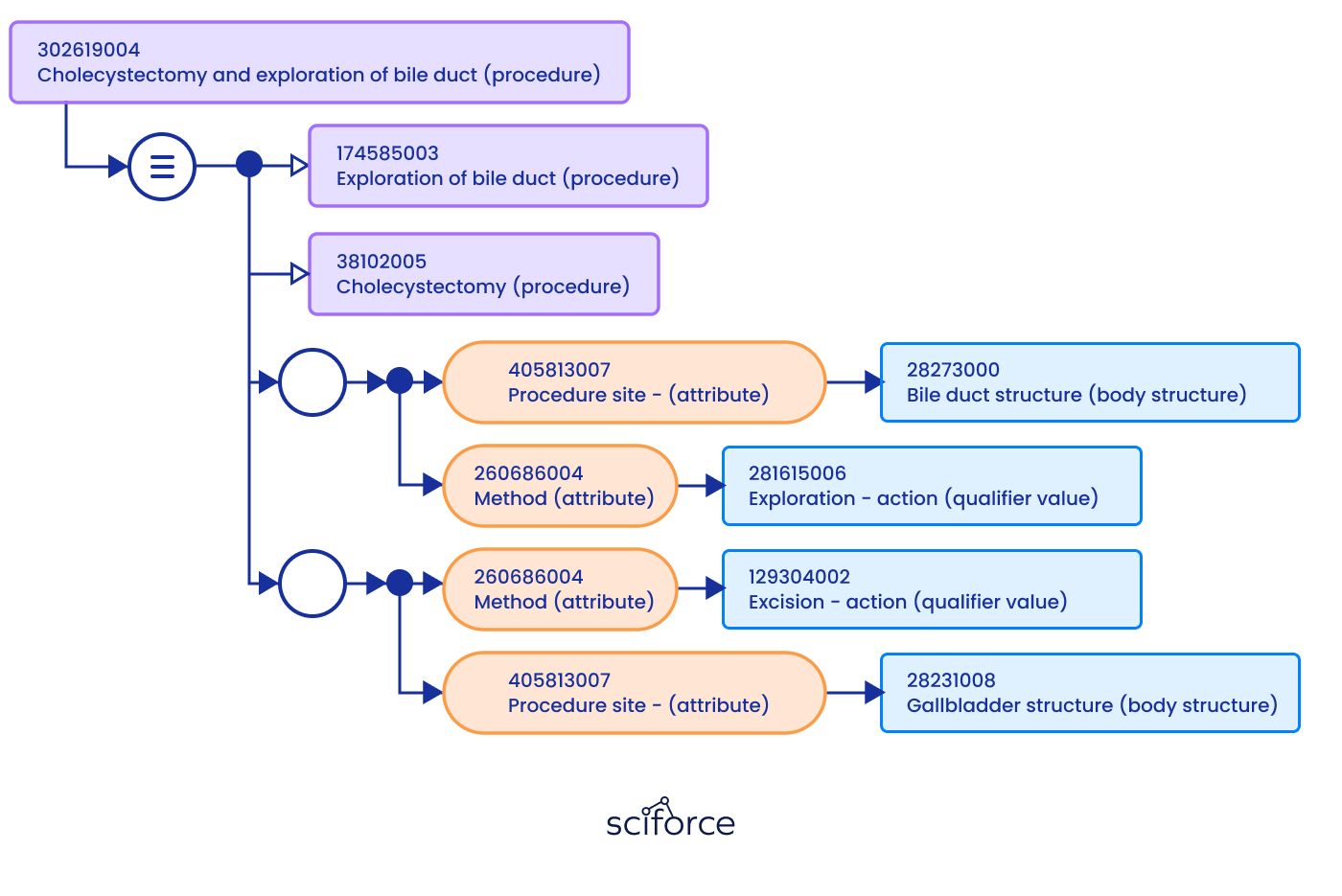
- Outcome
This automation transforms the data into a uniform format, making it immediately useful for clinical research, health monitoring, and predictive analytics. This ensures consistency across different healthcare systems and enhances data utility. Efficient Handling of Large Datasets Once data is standardized, Jackalope excels in handling large datasets efficiently.
- Process Automation
Jackalope utilizes automation to cut down on the need for manual data entry and review, which are often subject to errors and inconsistencies. The system's capacity to handle large volumes of data efficiently means it can manage increases in data without higher error rates or longer processing times.
- Scalability and Speed
The platform is engineered to dynamically scale, easily managing sudden increases in data typical in large healthcare environments. Jackalope's infrastructure is capable of parallel processing, which allows it to carry out multiple data conversions at once, greatly speeding up the time it takes to handle large datasets.
- Reliability Enhancement
Jackalope's machine learning algorithms continuously learn and improve, enhancing the accuracy of data handling over time. This self-improving process ensures the system becomes more effective, automatically adjusting to new data patterns and irregularities without needing manual input.
Semantic Integrity
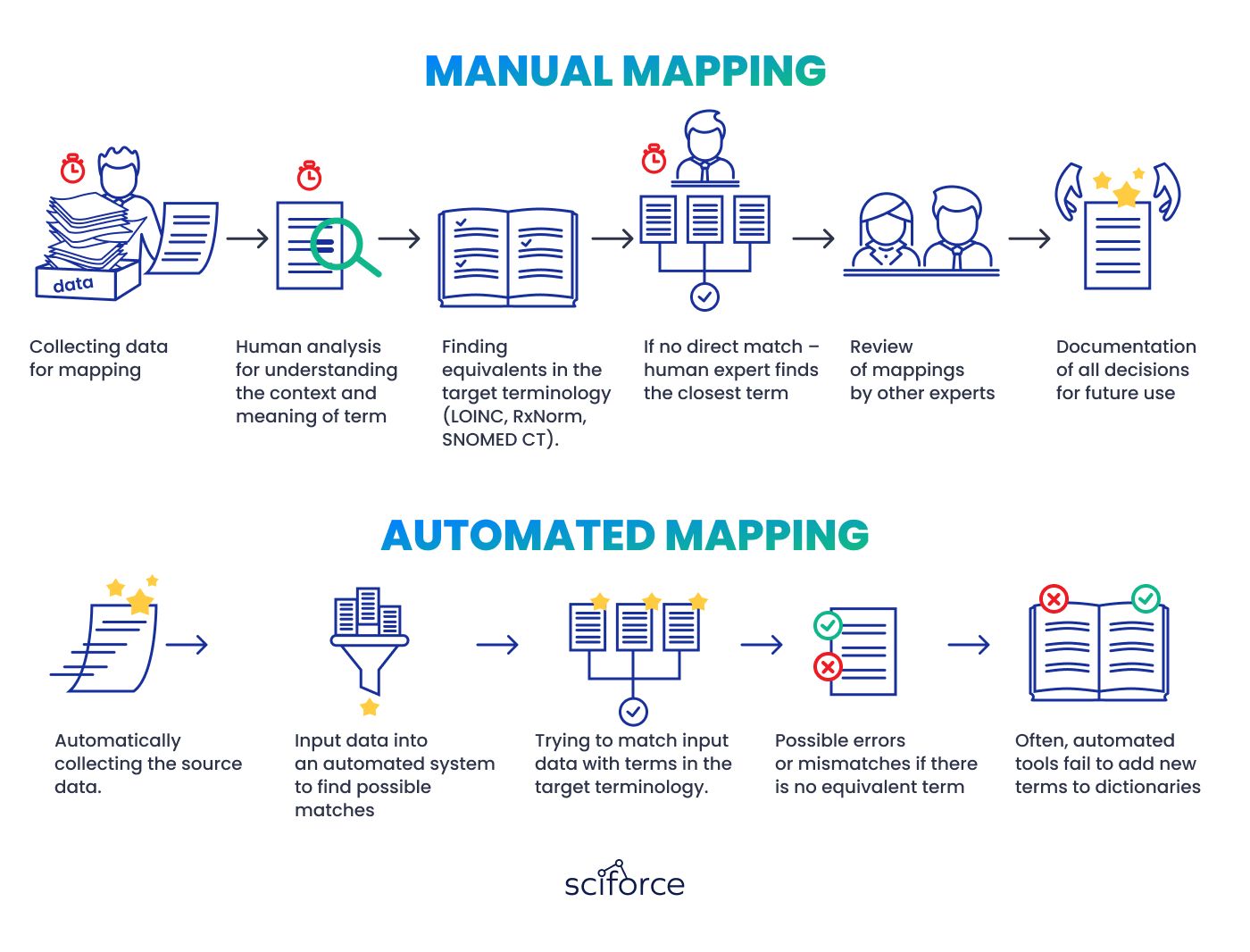
Semantic Mapping and Post-Coordinated Expressions
Jackalope ensures precise and comprehensive semantic mapping of medical data.
- Automated Generation of Expressions
Jackalope employs artificial intelligence algorithms to automatically create SNOMED post-coordinated expressions. These complex expressions enable the detailed and nuanced representation of medical conditions by combining various SNOMED codes.
- Comprehensive Semantic Capture
Accurately capturing and standardizing the semantic meanings of medical terms, especially those involving rare conditions, unique clinical scenarios, or new medical findings that do not have direct pre-existing codes in standard terminologies.
Intelligent Mapping and Dynamic Expression Generation
Beyond basic mapping, Jackalope dynamically generates expressions to ensure data accuracy.
- Advanced Algorithms for Term Mapping
Jackalope employs state-of-the-art algorithms designed to analyze and map medical terminology to the most appropriate existing categories within SNOMED CT and OMOP CDM databases. This mapping is crucial for ensuring data consistency and accuracy in clinical databases and research datasets.
- Creation of Custom Descriptions
When an exact match for a term does not exist within the standard vocabularies, Jackalope's system dynamically creates new, bespoke descriptions. This adaptability is essential for preserving the granularity and specificity of medical data, ensuring that unique or emerging medical terms are accurately incorporated into the dataset.
Handling Temporal and Granular Data
Jackalope also adeptly handles temporal and granular data, crucial for comprehensive patient care.
- Temporal Data Representation
Jackalope effectively manages and represents time-related information in medical records. This capability includes tracking disease progression, medication timing, and other time-sensitive aspects essential for long-term studies and effective patient care.
- Granular Data Management
The system ensures detailed and granular management of complex diagnoses and procedures, aligning them with the structured formats of OMOP CDM. This level of detail is necessary for in-depth medical analysis and supports high-precision clinical decision-making.
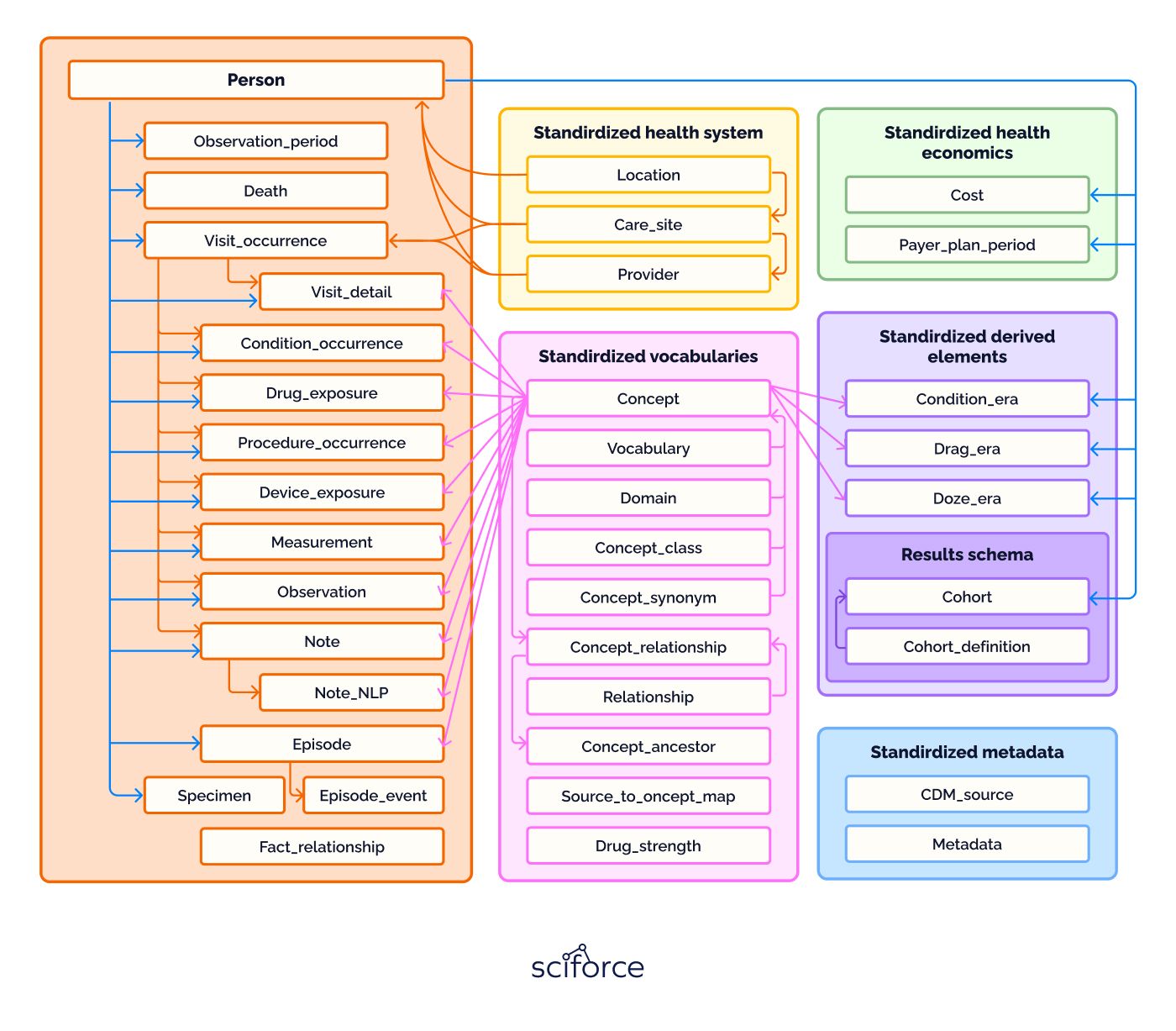
Enhancing Interoperability and Global Collaboration
Jackalope supports global healthcare collaboration through standardized frameworks.
- Standardized Data Frameworks
Jackalope utilizes the Observational Medical Outcomes Partnership Common Data Model (OMOP CDM) and the Systematized Nomenclature of Medicine – Clinical Terms (SNOMED CT) to standardize medical data. This standardization is crucial for easy exchange and understanding the data across various healthcare systems around the world.
- Global Data Sharing
By using these internationally recognized standards, Jackalope supports worldwide collaboration among researchers, clinicians, and healthcare organizations. The tool allows for the collection and analysis of data from varied geographic and clinical settings, improving the scope and quality of research and clinical practices.
Improving Data Integrity and Security
Finally, Jackalope ensures data integrity and security with rigorous protocols and advanced protections.
- Rigorous Update Schedules
Jackalope maintains a stringent update protocol for its databases, ensuring that all terminologies and mappings are current with the latest medical standards and discoveries. This continuous updating process is vital for keeping the system aligned with global healthcare advancements and ensuring that the data remains relevant and accurate.
- Robust Data Protection Measures
The platform is designed with advanced security features to safeguard sensitive medical information against breaches and unauthorized access. These measures include encrypted data storage and transmission, secure user authentication protocols, and regular security audits. Such precautions are critical not only for protecting patient privacy but also for ensuring compliance with international data protection regulations, such as GDPR in Europe and HIPAA in the United States.
Managing unstructured healthcare data remains a significant challenge. Healthcare systems generate vast amounts of clinical notes, medical images, and genetic test results daily, rapidly increasing in volume and complexity.
Jackalope addresses these challenges by leveraging advanced AI and machine learning technologies. By transforming unstructured data into standardized formats, Jackalope makes detailed patient information accessible, supports personalized treatments, and facilitates advanced medical research. With Jackalope, healthcare providers can use their data on its full, leading to better patient outcomes and more efficient healthcare delivery.
Jackalope is available for Beta now! Contact us to request early access.